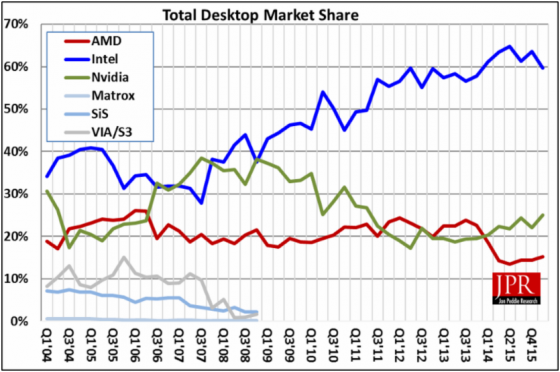AMD gains market share on Nvidia.
The market for add-in graphics boards (AIB) increased in the first quarter of 2016, according to the latest market report from Jon Peddie Research. AMD gained market share for the fourth consecutive quarter.
Quarter-to-quarter AIB shipments increased 4.8% and 5.8% year-to-year.

The JPR AIB Report tracks computer add-in graphics boards, which carry discrete graphics chips (GPUs). AIBs are used in desktop PCs, workstations, servers, and other devices such as scientific instruments. They are sold directly to customers as aftermarket products, or are factory installed. In all cases, AIBs represent the higher end of the graphics industry using discrete chips and private high-speed memory, as compared to the integrated GPUs in CPUs that share slower system memory.
The PC add-in board (AIB) market now has just three chip (GPU) suppliers, which also build and sell AIBs. The primary suppliers of GPUs are AMD and Nvidia. There are 48 AIB suppliers, the AIB OEM customers of the GPU suppliers, which they call “partners.”
Lots of AIB suppliers, smaller shipments
The news for the quarter was encouraging and seasonally understandable, quarter-to-quarter, the AIB market increased 4.8% (compared to the desktop PC market, which decreased -10.5%).
AIB shipments during the quarter increased from the last quarter 4.8%, which is above the ten-year average of -2.5%. On a year-to-year basis, we found that total AIB shipments during the quarter rose 5.8%, which is greater than desktop PCs, which fell 14.6%.
In addition to privately branded AIBs offered worldwide, about a dozen PC suppliers offer AIBs as part of a system, and/or as an option, and some that offer AIBs as separate aftermarket products. JPR has tracked AIB shipments quarterly since 1987; the volume of those boards peaked in 1999, reaching 114 million units, in 2015, 44 million shipped.
Gaming the game changer
However, in spite of the overall PC churn, somewhat due to tablets and embedded graphics, the PC gaming momentum continues to build and is the bright spot in the AIB market. The gaming PC (system) market is as vibrant as the stand alone AIB market. All OEMs are investing in Gaming space because demand for Gaming PCs is robust. Intel also validated this on their earnings call, with the recent announcement of a new Enthusiast CPU. However, it won’t show in the overall market numbers, because like gaming GPUs, the gaming PCs are dwarfed by the general-purpose machines.
The overall GPU shipments (integrated and discrete) is greater than desktop PC shipments due to double-attach—the adding of a second (or third) AIB to a system with integrated processor graphics—and to a lesser extent, dual AIBs in performance desktop machines using either AMD’s Crossfire or Nvidia’s SLI technology.
Improved attach rate
The attach rate of AIBs to desktop PCs has declined from a high of 63% in 1Q08 to 44% this quarter, an increase of 17.1% from last quarter (which was a pretty good quarter). Compared to this quarter last year it increased 23.9%.
With lackluster applications (other than games), and the failure of Windows 10 to spur the market, consumers for the most part—but also commercial buyers—extended their buying cycle out from three to four or more years. They still need and use PCs, but not the latest ones. The exception, and only bright spots, have been the gaming segment and professional graphics. As a result, JPR sees consumers buying AIBs to gain performance improvements and not upgrading the PC as frequently






